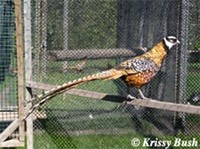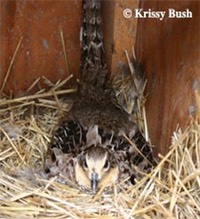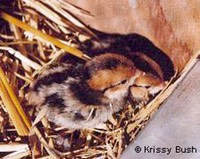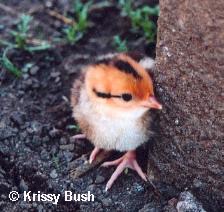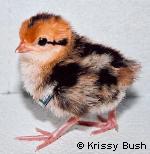Scientific Information
Class: Aves
Order: Galliformes
Family: Phasianidae
Subfamily: Phasianinae
Genus: Syrmaticus
Species: Syrmaticus reevesi
Species English name: Reeves Pheasant
CITES Status: not endangered
Distribution: Central China
(from A Monograph of Pheasants Volumes III & IV, William Beebe)
Description
• Male - White head with black bandit mask and black ring around the neck. Golden yellow body marked with black scale pattern. White replaces gold on most of the wing. Chestnut belly. Gold and white long tail marked with black and chestnut barring. Red wattles.
• Female - Body is mostly a light brown with golden buff markings. Light chocolate crown and bandit mask. Golden buff face and neck. Long light brown tail with tan and darker brown barring.
• Chicks - Golden balls of fuzz with an orange hue. Dark eye streak and other dark markings. One of the cutest pheasant chicks.
Diet
• We feed our breeders and young adults 16% layer pellets, our tiny chicks 25% Turkey Starter crumble, and our growing chicks 20% crumble.
• They get a handful of mixed grains every second day except during breeding season, fresh greens (lettuce, chickweed, dandelions, grass) and fruits (tomato, grapes, berries, etc.) when available.
Breeding
• Done in pairs or trios. Get great fertility either way.
• Reeves are first year birds meaning that the female will lay eggs the spring after she is hatched. The male is fully fertile the first year.
• They start laying eggs around the tenth of April and will lay every second day until they lay approximately 30 eggs.
• They lay a small round olive tan egg.
Incubation
• Eggs are collected twice a day and marked with the date and breeding pen number and set daily.
• Eggs are set in an automatic turning Lyons Roll-X (RX2) with grid 109.
• Temperature 99.8°F, humidity-wet bulb 84 with humidity adjusted periodically depending on development of the air space shown by candling
• On the final day of incubation, each egg is placed in its own oval wire mesh hatching basket (6" x 3" x 3") and set in the Sportsman Ratite hatcher.
• Incubation for Reeves is 24 days.
• After the chick hatches, it stays in the hatcher for a minimum of 8 hours.
Chicks
• They start out in our round 18" brooder pen with a mixed assortment of chicks. After a few days they are separated into a 2' x 4' baby pen for about four days to a week. They are then transferred to all Reeves 2' x 6' pen for the next 7-9 weeks. If they are not put into an all Reeves pen, they will grab the toes or forehead feathers of the other chicks and flip them around the pen. If an all Reeves pen is not an option, they can be put with much larger chicks of a non aggressive type. They stay with this grouping until they go outside. All of these brooding pens have wire bottoms with a heat lamp at one end and feed & water at the other end. The heat lamp is attached to a dimmer switch so we can turn down the amount of heat as the chicks get older until it is turned off completely. Reeves chicks are debeaked often and are moved off of the heat quicker than the other varieties.
• After they are off of the heat for a few weeks, they are moved outside to the pheasant house (has outside grassy pens and a heated inside house part where they are blocked in for the night). After they are toughened up, they are moved to an outside chick pen.
• Chicks are quite easy to raise with their own kind. You can mix both sexes, but once they are near maturity, the more dominant males tend to harass and eventually kill the less dominant males. At this point it is wise to separate them into one male per pen with either one or multiple females.
Pens
• 25' long x 10' wide x 6' high with a 4' x 4' x 4' house in the middle.
• Pens are covered with 2" diamond top-rite.
• Pens contain grass, which needs to be mowed every few weeks to a month because they aren't very hardy grass eaters.
• See Scintillating Copper Article for predator proofing set-up
Behavior
• Are generally calm birds. Males can be either quiet or aggressive. Aggressive males will attack and stalk you when you enter the pen and can be quite dangerous with their large spurs.
• They make a hard to describe continuous chirping noise. It is similar to a turkey gobble, but closer to a high pitched chirp.
• They are relatively easy to tame and are friendly birds that come running when you have treats.
Article By Krissy & Donna Bush
Pheasant Ridge
